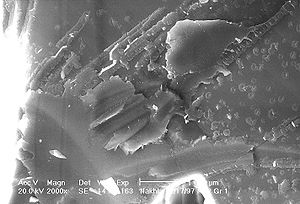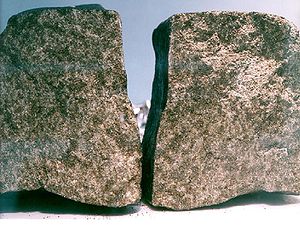- Nakhla meteorite
-
 Scanning electron microscope (SEM) image of the surface of a grain of the meteorite showing small pits filled with material. On Earth, such pits are carved by bacteria.
Scanning electron microscope (SEM) image of the surface of a grain of the meteorite showing small pits filled with material. On Earth, such pits are carved by bacteria.
 SEM image of a chip of the Naklha meteorite, depicting biomorph material: the larger, broad knife-like and the small, donut-shaped features.
SEM image of a chip of the Naklha meteorite, depicting biomorph material: the larger, broad knife-like and the small, donut-shaped features.
Nakhla is a famous martian meteorite fallen in Egypt in 1911.
Contents
History
It fell to Earth on June 28, 1911, at approximately 09:00, in the Nakhla region of Abu Hommos, Alexandria, Egypt.[1][2] Many people witnessed its explosion in the upper atmosphere before the meteorite fell to Earth in an area of 4.5 km in diameter, and about forty pieces were recovered[3] ; the fragments were buried in the ground up to a meter deep. From an estimated original weight of 10 kg (22 pounds), recovered fragments ranged in weight from 20g to 1813g.[1]
The Nakhla dog
One fragment of the meteorite was said to have landed on a dog, as observed by a farmer named Mohammed Ali Effendi Hakim in the village of Denshal, near Nakhla, supposedly vaporizing the animal instantly. Since no remains of the dog were recovered and there were no other eyewitness to the dog's demise, this story remains apocryphal.[1] However, the story of the Nakhla dog has become something of a legend among astronomers.
Classification
It is the prototypical example of a Nakhlite type meteorite of the SNC Group of Mars meteorites.
Martian origins
Thirty-four meteorites thought to have originated from Mars have been catalogued from around the world[4], including the Nakhla meteorite. These are considered to have been ejected by the impact of another large body colliding with the Martian surface. They then travelled through the solar system for an unknown period of time before penetrating the Earth's atmosphere.
Signs of water
Nakhla is the first Martian meteorite to show signs of aqueous processes on Mars. The rock contains carbonates and hydrous minerals, formed by chemical reactions in water. In addition, the rock was exposed to water after it formed, which caused secondary accumulations of minerals. The carbonates contain more 13C than rocks formed on Earth, indicating Martian origin.[5]
Signs of life
In March 1999, after receiving part of the meteorite from the British Museum in 1998[3] , a team from NASA's Johnson Space Center examined the Nakhla meteorite using an optical microscope and a powerful scanning electron microscope (SEM), revealing biomorphic forms of a limited size range, among other features.[6] London's Natural History Museum, which holds several intact fragments of the meteorite, allowed NASA researchers to break one open in 2006, providing fresh samples, relatively free from Earth-sourced contamination. These scientists found an abundance of complex carbonaceous material occupying dendritic pores and channels in the rock, reminiscent of the effects of bacteria observed in rocks on Earth[7].
A debate was opened by some at the 37th Lunar and Planetary Science Conference in March 2006 in Houston, Texas, postulating that the carbon-rich content within the pores of the rocks hinted at the remains of living matter. However, because carbon is the fourth most abundant element in the universe (after hydrogen, helium, and oxygen), the presence of shapes reminiscent of living organisms has itself proved insufficient to convince all scientists that bacteria once lived on Mars.[8]
Amino acids within the meteorite
In 1999, various amino acids were isolated from the meteorite fragment at Johnson Space Center. Among them were aspartic acid, glutamic acid, glycine, alanines, and butyric acid. However, it is not clear whether they were originally from the meteorite or the product of terrestrial contamination.[5]
See also
- ALH84001 martian meteorite.
- Shergotty meteorite
- Life on Mars
References
- ^ a b c "The Nakhla Meteorite" - From NASA's Jet Propulsion Laboratory
- ^ "Nakhla meteorite fragment" - From the Natural History Museum. Rotatable image of a fragment of the meteorite. URL accessed September 6, 2006.
- ^ a b McBridge, Kathleen M.; Righter, K.. "The 100th Anniversary of the Fall of Nakhla: The Subdivision of BM1913,25". NASA. Johnson Space Flight Center. http://hdl.handle.net/2060/20110014358. Retrieved 15 September 2011.
- ^ "Mars Meteorites". NASA. http://www2.jpl.nasa.gov/snc/index.html. Retrieved 2010-02-16.
- ^ a b Glavin, Daniel P. Amino acids in the Martian meteorite Naklah. Retrieved 2010-11-13.
- ^ "Space rock re-opens Mars debate" - February 8, 2006 BBC News article. URL accessed September 6, 2006.
- ^ BBC News - Space rock re-opens Mars debate
- ^ BBC News - Life on Mars - new claims
External links
Mars Areography General- Observation history
- Albedo features (Solis Lacus)
- Atmosphere
- Canals (list)
- Climate
- Color
- Water
- Glaciers
- Life
- North Polar Basin
- Chaos terrain
- Noachian
- Soil
Regions- Alba Mons
- Albor Tholus
- Arsia Mons
- Ascraeus Mons
- Biblis Tholus
- Elysium Mons
- Hecates Tholus
- Olympus Mons
- Pavonis Mons
- Syrtis Major Planum
- Tharsis
- Tharsis Montes
- North Polar Basin
- Hellas Planitia
- Argyre Planitia
- Schiaparelli
- Gusev
- Eberswalde
- Bonneville
- Eagle
- Endeavour
- Endurance
- Erebus
- Victoria
- Gale
- Galle
- Ibragimov
- Santa Maria
- Valles
- Chasmata
- Outflow channel
- Valles Marineris
Moons Specific- Phobos
- (Features
- Stickney crater
- Monolith)
- Deimos
- (Features)
CommonExploration Past and
CurrentFutureAstronomy EclipsesAsteroidsMeteorites Other topics - Darian calendar
- Timekeeping on Mars
- Flag of Mars
- In Fiction
- Martian
- Mars Society
- (FMARS
- MDRS)
- Mars Institute
- (Haughton–Mars Project)
- Mythology
- Ocean Hypothesis
Categories:- 1911 in science
- 1911 in Egypt
- History of Egypt (1900–present)
- Mars
- Meteorites
- Geology of Egypt
Wikimedia Foundation. 2010.


